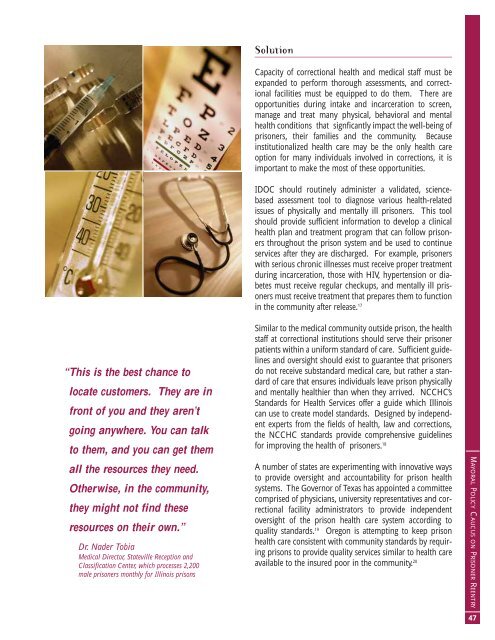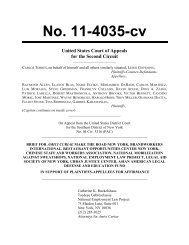Rebuilding Lives. Strengthening Communities.
Rebuilding Lives. Strengthening Communities.
Rebuilding Lives. Strengthening Communities.
Create successful ePaper yourself
Turn your PDF publications into a flip-book with our unique Google optimized e-Paper software.
“This is the best chance to<br />
locate customers. They are in<br />
front of you and they aren’t<br />
going anywhere. You can talk<br />
to them, and you can get them<br />
all the resources they need.<br />
Otherwise, in the community,<br />
they might not find these<br />
resources on their own.”<br />
Dr. Nader Tobia<br />
Medical Director, Stateville Reception and<br />
Classification Center, which processes 2,200<br />
male prisoners monthly for Illinois prisons<br />
Solution<br />
Capacity of correctional health and medical staff must be<br />
expanded to perform thorough assessments, and correctional<br />
facilities must be equipped to do them. There are<br />
opportunities during intake and incarceration to screen,<br />
manage and treat many physical, behavioral and mental<br />
health conditions that signficantly impact the well-being of<br />
prisoners, their families and the community. Because<br />
institutionalized health care may be the only health care<br />
option for many individuals involved in corrections, it is<br />
important to make the most of these opportunities.<br />
IDOC should routinely administer a validated, sciencebased<br />
assessment tool to diagnose various health-related<br />
issues of physically and mentally ill prisoners. This tool<br />
should provide sufficient information to develop a clinical<br />
health plan and treatment program that can follow prisoners<br />
throughout the prison system and be used to continue<br />
services after they are discharged. For example, prisoners<br />
with serious chronic illnesses must receive proper treatment<br />
during incarceration, those with HIV, hypertension or diabetes<br />
must receive regular checkups, and mentally ill prisoners<br />
must receive treatment that prepares them to function<br />
in the community after release. 17<br />
Similar to the medical community outside prison, the health<br />
staff at correctional institutions should serve their prisoner<br />
patients within a uniform standard of care. Sufficient guidelines<br />
and oversight should exist to guarantee that prisoners<br />
do not receive substandard medical care, but rather a standard<br />
of care that ensures individuals leave prison physically<br />
and mentally healthier than when they arrived. NCCHC’s<br />
Standards for Health Services offer a guide which Illinois<br />
can use to create model standards. Designed by independent<br />
experts from the fields of health, law and corrections,<br />
the NCCHC standards provide comprehensive guidelines<br />
for improving the health of prisoners. 18<br />
A number of states are experimenting with innovative ways<br />
to provide oversight and accountability for prison health<br />
systems. The Governor of Texas has appointed a committee<br />
comprised of physicians, university representatives and correctional<br />
facility administrators to provide independent<br />
oversight of the prison health care system according to<br />
quality standards. 19 Oregon is attempting to keep prison<br />
health care consistent with community standards by requiring<br />
prisons to provide quality services similar to health care<br />
available to the insured poor in the community. 20<br />
MAYORAL POLICY CAUCUS ON PRISONER REENTRY<br />
47
















